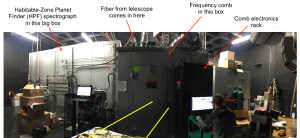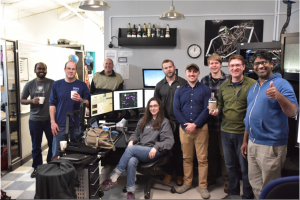We now have the results of the 19-2 observing period which covers from April through the end of July. During this period we were down for bad weather for 37% of the nights and spent 16.5% of the remaining time doing engineering or instrument commissioning. Looking at just the clear science time we had the instruments collecting photons 64% of the time. This better than previous periods and is likely due to the improvements made by the TCS and night staff team to trim down setup times. We only had 4% down time which suggests the HET is returning to a steady state of reliability. Our program completion rates fell in the normal range and were 96%, 89%, 91% 72% for our Priority 0, 1, 2 and 3 time. Of particular note is that we completed 91% of our HETDEX allocation for this period.
Author Archives: shetrone
VIRUS reaches 50+
Much like it is for the blogger, it is a real milestone for VIRUS to hit 50. In the case of VIRUS it is 50 units. This was achieved over this past weekend after spending several months with just 47 units.

Reconstruction from 50 IFU/VIRUS units on the sky. Each small square is 50 arcseconds on a side. There is actually a gap of 50 arcseconds between each IFU/VIRUS unit but it has been compacted in this view to avoid to much white space.
This means with every 6 minute exposure we take on the sky we get over 22,000 spectra!
On Monday we installed 2 more units bringing us to 52!!! Well on our way toward HETDEX science!
New Position: July 25, 2018 – Opto-mechanical technician
*** As of November 26th, 2018, this position has been filled ***
McDonald Observatory at The University of Texas at Austin, has an opening for an opto-mechanical technician at the Hobby-Eberly Telescope (HET); a state-of-the-art optical telescope facility located in the Davis Mountains of West Texas, 16 miles from Ft. Davis, Texas (440 miles west of UT Austin campus). This position is responsible for maintaining the many optical systems throughout the facility with the principal focus on the large (10 meter), multi-segmented (91 mirrors), primary mirror. Maintaining the primary mirror involves removing and installing individual segments (swapping) as well as sustaining the critical peripheral systems required to support this array. The critical support systems include 1) the Segment Alignment and Maintenance System (SAMS), a sensor system that measures the figure of the primary mirror 2) the Segment Control System (SCS), a motor driven positioning system for each of the individual mirror segments and 3) the mirror frame, a mechanical system designed to hold each segment in place. Other work includes supporting the mirror coating process and thorough record keeping to document the work performed and the state of the various subsystems.
Required qualifications: Bachelor’s degree in science or engineering, or a related field; equivalent combination of relevant education and experience may be substituted as appropriate. Preferred qualifications: Two years experience working with optical systems and/or a laboratory environment. Math skill set including linear algebra and calculus. Computer skill set including programming fundamentals, MATLAB, LabView. Ability and/or experience with directing and/or managing projects. Ability to do basic troubleshooting on both electrical and mechanical systems. In addition, candidates should have the work ethic and drive to maximize the scientific output of the telescope.
Visit http://utdirect.utexas.edu/apps/hr/jobs/nlogon/search/0/ for a complete job description and to apply for job posting number 18-07-20-01-4216. For more information about the telescope and McDonald Observatory visit http://www.as.utexas.edu/mcdonald/het/het.html. Security sensitive position; conviction verification on applicant will be conducted. UT Austin is an Equal Opportunity/Affirmative Action Employer committed to diversity.
The week of July 23, 2018
This week at the HET we have taken the top end of the telescope so that we can rework the layout of the IFU fibers and add 11 new fibers. That will leave just 17 IFU fibers to be installed. Just to be clear this is not spectrographs being installed but just the IFU fibers that feed future spectrographs. At the moment we have 41 spectrographs units installed and stable. This means we are not more than half way towards our total goal of ~78 units.
The week of July 2nd 2018
It has been a while since I posted and I think one of our biggest pieces of new is that we are now regularly observing with HPF. Not only is this instrument being used to observe host stars for planets but there are astronomers who are using it to observe planetary nebulae looking for new elements being born in the deaths of stars just slightly heavier than our sun. This new instrument is easy to use, reliable and a great addition to the HET.
The other big news is that we now have 40 double barreled spectrographs installed within VIRUS. That means that we are now more than half way to have VIRUS fully populated.
New Telescope operator positions open at the HET
*** As of November 26th, 2018, both Telescope Operator positions have been filled ***
We have two new openings at the Hobby-Eberly Telescope for telescope operators. One of our operators has moved on to be a technical manager for the new earth observatory being built by NASA at McDonald Observatory and the other is going to also work for NASA as a telescope operator on the Sofia flying observatory. While sad to see friends moving on it is great to know that we are hiring and training the best people! Maybe you know someone who might be our next telescope operator!? The add is below:
The Hobby-Eberly Telescope (HET) at the University of Texas at Austin, a state-of-the-art optical telescope facility located in the Davis Mountains of West Texas, has an opening for a Telescope Operator (TO). The TO is responsible for the operation of the telescope, dome and instruments for night-time observations while working with the Resident Astronomer to acquire data. The TO maintains the records and logbooks detailing the activities during the observing period. Local weather and facility conditions are monitored to insure adequate and safe observing conditions. Some day time responsibilities include: assisting the day staff in the resolution of technical problems and preparing the facility for night time operations.
Required qualifications: Bachelor’s degree in astronomy, computer science, engineering, or a related field; equivalent combination of relevant education and experience may be substituted as appropriate. Preferred qualifications: Completion of advanced courses leading towards a master’s degree in a STEM field and/or one or more years experience with operation of a 1+m telescope, understanding of observational astronomical terminology, experience with developing and adapting to changes in complex procedures for repetitive tasks, experience with quickly trouble shooting, documenting and working through faults in complex hardware and software systems, and experience working in a Linux or Unix environment through both command-line interfaces and GUIs. In addition, candidates should have the work ethic and drive to maximize the scientific output of the telescope. The work schedule will be determined with the Supervisor and will include nights and weekends.
For more information about the telescope and the McDonald Observatory visit http://www.as.utexas.edu/mcdonald/het/het.html. To view a complete job description, salary, benefits and application instructions visit http://utdirect.utexas.edu/apps/hr/jobs/nlogon/search/0/ and refer to job posting number: 18-07-06-01-4216. This position is security sensitive and therefore the offer is contingent upon successfully passing a criminal conviction background check. The University of Texas, as an equal opportunity/affirmative action employer, complies with all applicable federal and state laws regarding nondiscrimination and affirmative action.
The week of April 16
This week we had a number of break through moments. Perhaps the most prominent is that after weeks of rewiring and adding new shielding we may finally be at a point where the VIRUS array is fairly stable. We have 36 VIRUS units installed (each unit is 2 spectrographs) so a total of 72 spectrographs up for the last 5 days.
Another big breakthrough is in observing automation. We have a piece of software called OCD (Observatory Conditions Decision tool) which monitors the metrology (seeing, transmission and sky brightness) from the telescope and decides if HETDEX observations can be made. If allowed it will also take over the control of the TCS and VIRUS instrument and start observing HETDEX targets with only brief pauses to get confirmation from the telescope operator that we are on the right setup star. Using this new tool we were able to observe a full night of HETDEX targets with a minimum of overhead (even a few targets with just 3 minute setup times). This is faster than the fastest resident astronomer and telescope operator pair working together. Congratulations to the HETDEX software team who traveled out from Germany to help us get it all working efficiently.
The week of February 26, 2018
This week we continued with HPF and Laser Frequency Comb (LFC) commissioning. We made a lot forward progress in getting spectra with the comb and had our official “first light”. Below are a few pictures that might help visualize some of what transpired.

A part of the spectrum from HPF which shows the very regular picket fense of emission lines generated from the LFC just below a stellar spectrum. The spectra are stacked up in an echellogram.
The week of February 19, 2018
In the last week we have had a few updates for two of our instruments. For VIRUS we are up to 29 working spectrographs. We actually have several more units but some of the oldest and slightly mis-behaving units have been sent back to Austin for realignment and recommissioning. For HPF we are thrilled to announce that a NIST laser comb has been installed in the calibration room in the HET basement. This allows us to send a picket fence of spectral features through a separate fiber next to the science fibers. During the data reduction and analysis of the HPF spectra they can look at the position of these pickets and determine how the instrument might be subtly moving and correct for it. So far it seems like it is working great.
The week of November 6
A brief advertisement before we get into this week’s news: One of our Resident Astronomers is retiring. If you are a PhD astronomer and interested in working on one of the largest optical telescopes in the world doing cutting edge research please consider applying: https://utdirect.utexas.edu/apps/hr/jobs/nlogon/171020014209
This week the big changes to the telescope have been the removal of the Prime Focus Instrument Platform (PFIP) work platform and the arrival of 3 more VIRUS units. The PFIP work platform, as the name suggests, allowed us to drop people off to work on the PFIP. We will still be able to work on the PFIP but now we have to do it from the JLG worker-lift. The work platform covered up a number of mirrors (about 10% of the light collecting area) as can be seen in the images below taken with our pupil viewing camera.

Two images of the HET pupil taken with our pupil viewing camera before (left) and after (right) the PFIP work platform was removed.
With the delivery of 3 more VIRUS units we now have 28 working VIRUS units or 56 spectrographs or more than 12,000 fibers on the sky!


